Today, we are going to do a simple yet tasteful sensory activity that reveals the science behind the two different states of matter i.e. solids and liquids.
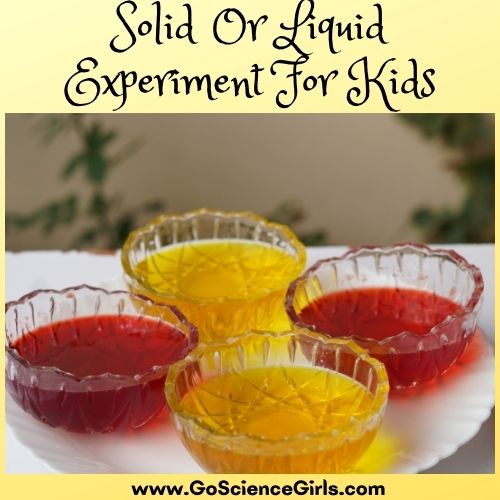
That means we are teaching children about the differences and formation of solids and liquids. Conducting this hands-on sensory activity turns your child’s play time into a science activity classroom lesson.
Also, an excellent idea to keep your children engaged and entertained in a meaningful way. Let us begin!
Solid or Liquid Sensory Play
Inspiration
My two children are Jelly Lovers! One day, we ran out of jelly stock in the home and my little one started being cranky for eating jelly. So, my elder daughter said, ‘why don’t we make jelly at home’? Then, immediately I browsed over internet about how to make jelly at home and came across this wonderful recipe. This is not just a jelly recipe but a great edible sensory activity that teaches children about solids and liquids formation.
Age Group: This edible science activity is perfect for toddlers, kindergarten, elementary and up to middle school children. This is a perfect sensory play time activity for toddlers and kindergarteners.
What is a jelly?
Jelly is a sweet and elastic dessert usually made up of gelatine. It is known with different names depending on the location. In some regions, it is known as jelly-O or simply jello whereas in some other regions, it is referred as gelatin or gelatine. Do not confuse yourself this dessert food thingie with the fruit preservative gelatin. Do you know about the nursery school jingle on jelly? If not have a look at it or if you already knew it, just recall:
Jelly on a plate.
Jelly on a plate.
Wibble, wobble, wibble, wobble,
Jelly on a plate!
My children enjoyed this edible science activity by singing this wonderful and catchy rhyme!
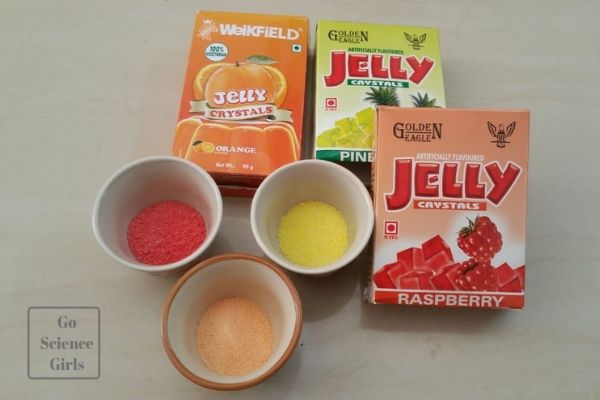
Predictions
You can ask your children to do predictions on what is going to happen during and after the experiment. Here are some of the questions you can ask them:
- How jelly formations happen?
- How long does it take to form jelly crystals?
- Does adding hot water to jelly mix powder create jellies?
- What happens if we use normal tap water in the experiment?
- Does adding chilled water makes any difference in giving final results?
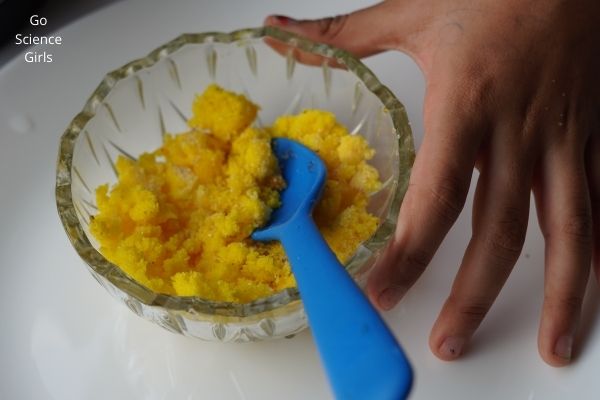
Materials Required:
1) Four Different Glass Bowls
2) Three different flavoured jelly mix (You can use store-bought jelly mix. We chose orange, pine apple, and raspberry flavors in order to achieve orange, yellow, and red colored jellies respectively)
3) Hot water
4) Gelatine Powder (Optional)
5) Spoon or Spatula for mixing
6) White Ceramic Plate
Simple Step-by-Step Instructions to make Solid or Liquid Sensory Play Fun
This super fun activity brought a lot of giggles on my children face while exploring the science of matters in an educational way.
Step-1: Little Preparations
Take four glass bowls and clean them with neat hands. Later allow them for drying using paper or cloth towels. If your glass bowls contain any contaminated materials, the outcome may differs. So, it is important to use cleaned bowls for experiment. Why glass bowls? Because glass bowls offer a great view to observe the changes and results that happen while experimenting. Also, keep some hot water ready before you start the activity.
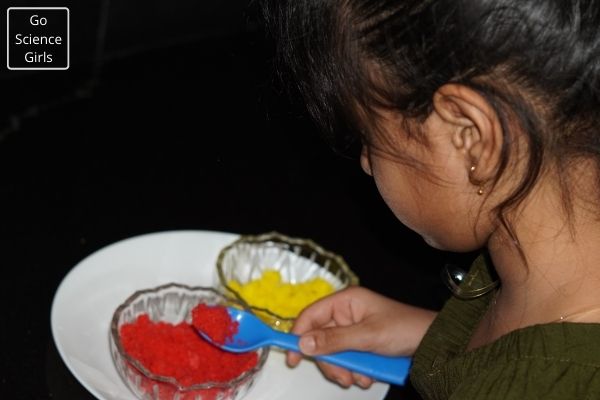
Step-2: Labelling Experiment Things
Labelling things give a professional look to our simple science activities and keeps everything clear. Such that your little scientist do not confuse between different materials used and their respective results. Hence, it is most important thing to give labelling to the bowls regarding which material is going inside which bowl.
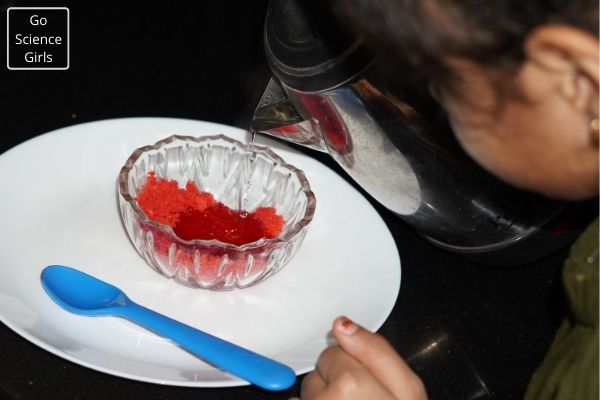
Step-3: Mix Jelly and Gelatine Packets
Now, it is time to set up your experiment table and start performing the activity: My kids showed very much interest and excitement to mix jelly and gelatine packets into the hot water. Here are the simple instructions I gave them to follow in order to see perfect and beautiful jelly in the glass bowls. Have a look:
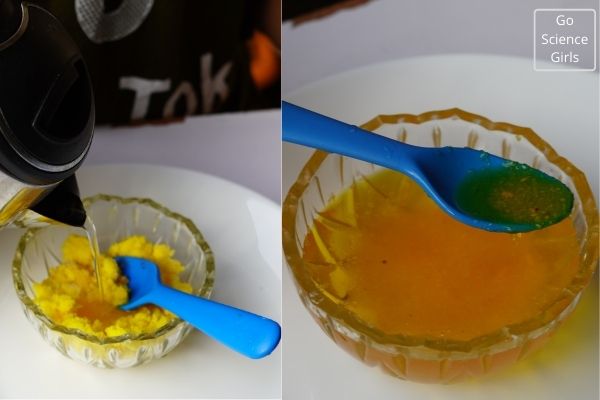
1) In glass bowl-1, take a little amount of jelly mix powder (orange flavored) and pour some hot water
2) In glass bowl-2, add little amount of jelly mix (raspberry flavor) and mix it with hot water.
3) In glass bowl-3, add a little amount of jelly mix (Pineapple flavor) and hot water
4) In glass bowl-4, take some quantity of gelatine powder and mix it with hot water
Then, keep all the experiment bowls in the fridge for some time to see the final outcome.
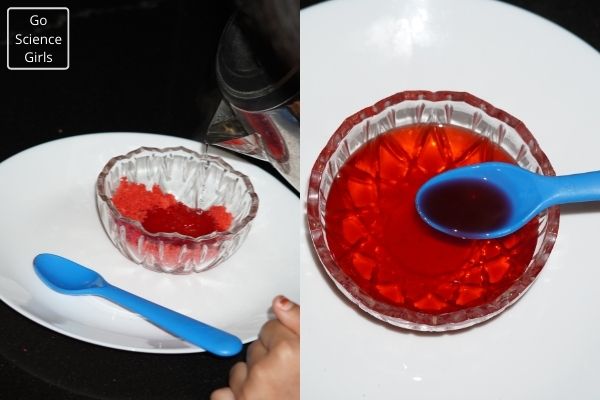
Step-5: Keep Tracking
Let the mixtures settle for some time and do not forget to ask your child to keep tracking the observations and results. The mixtures slowly turn into solid jell form from the liquid form. Tracking the jelly formations is a playful and multi-sensory learning experience for children.
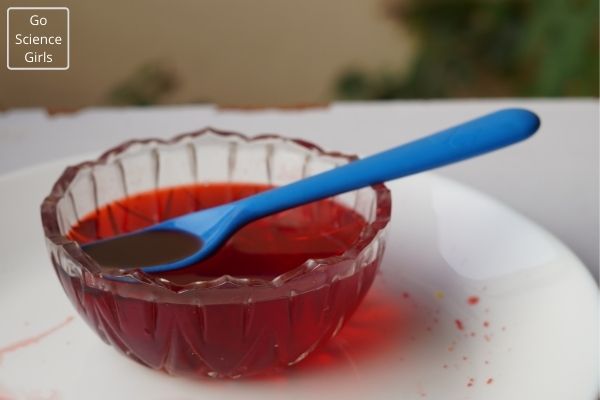
Results
My kids enjoyed the surprising results and the most interesting and exciting thing for them is tasting the jelly crystals. And my children found the jelly mix crystals are tastier than the plain gelatine crystals. They also observed and told me that the crystals formed from jelly mix are different from the ones of gelatine mix. The difference is that the jelly mix crystals looked like big crystals colored and stuck together whereas the gelatine crystals are small and not stuck together properly.
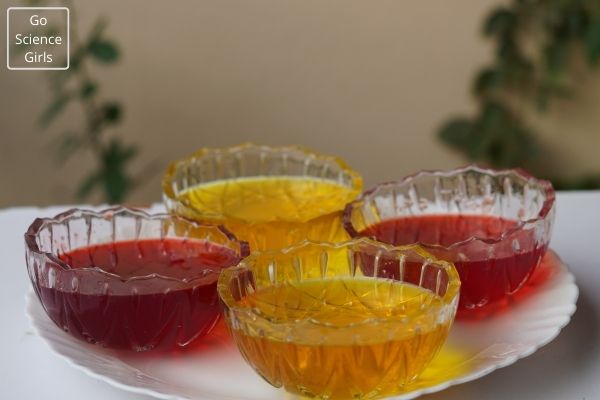
When my girls took out the experiment bowls from the fridge, they observed the following changes:
- Change in the temperatures inside bowls
- Difference in the texture of jelly formed in four bowls
- Feeling wet fingers when kept inside jelly bowls
- The most interesting part is that little ones broke the jelly in between their fingers and observed whether it get back to its liquid state again. This was a wonderful idea to enjoy the texture of jelly as well. Soon after they implemented their idea and came to a conclusion that jelly do not get back to liquid state again when squished or disturbed.
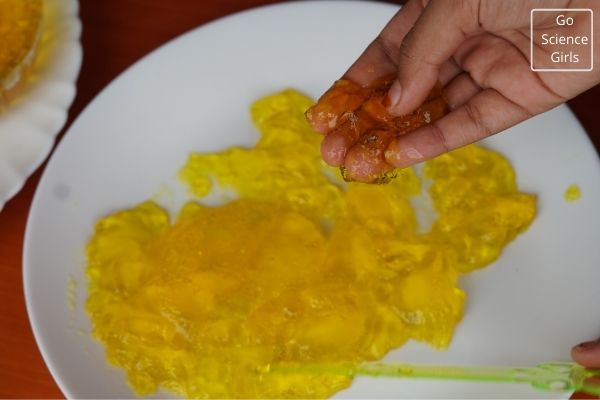
I am very much happy again noticing their observations over the experiment results!!
Our Experience while Performing the Science Experiment
This is completely a fun-filled science exploration about different states of matter. This is so simple and easy that you won’t imagine my children performed this whole activity on their own. Right from setting up the experiment table to pouring hot water in to the glass bowls to observing and noting down the results. As a mother I felt very happy to see my children doing science activities on their own. Except boiling the water, my children managed rest all the work to see fascinating and edible results.

Discussions
You can discuss a lot of science while performing this fun science activity with your children. Let us see a few of them:
- Talk over about how liquids and solids form.
- Chat how the liquid mixture turned into a solid jelly.
- Ask about how liquids turn into jellies and also ask them why the liquids took the shape of a bowl when solidified.
- What is the ideal temperature of hot water that go into the bowl filled with jelly mix?
- At what temperature the jelly remain in solid state?
- Does the jelly get back to its original liquid state when provided with particular warmer or colder temperatures?
Let us have a brief discussion about science of matters terminology…
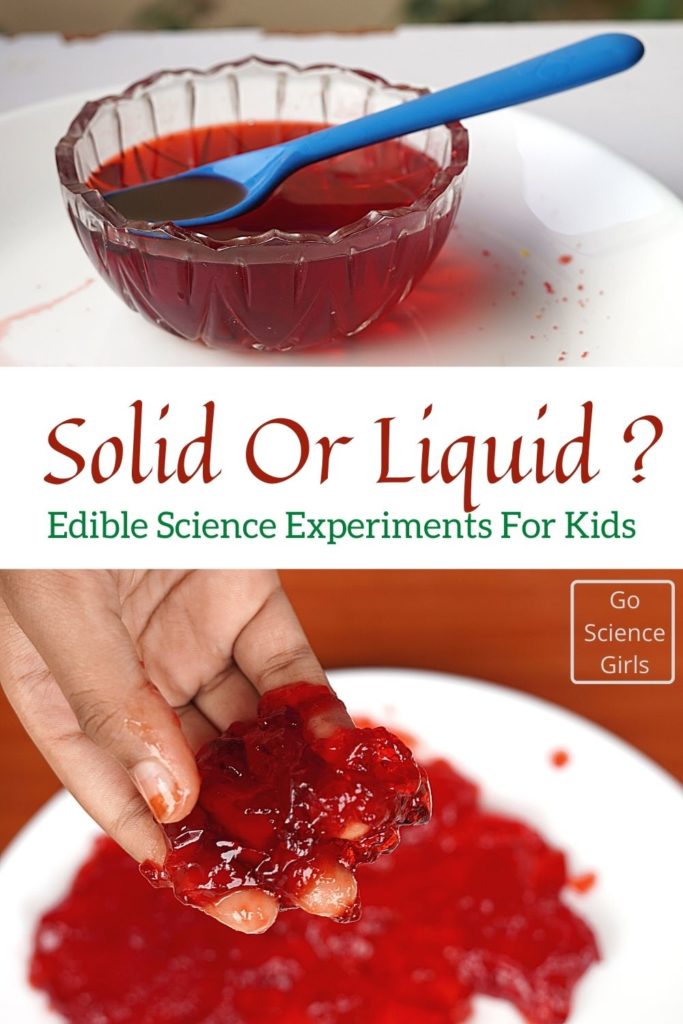
What is a matter?
Matter is anything around us, which we can touch, feel, and breathe! Scientifically, our scientists characterize a matter as a thing that has specific mass and space. In our daily life activities, we come across a lot of matters which are mainly divided into three parts: Solids, Liquids, and Gases.
Define Solids
Solids are the substances categorized by its physical firmness and resistance to tolerate the surface force. And the particles inside the solid substances stick together closely and shows very less kinetic energy. Solids are one of the main states of matter that shows stable shape.
For ex: Pencil, Beetroot, Rice Grain, etc.
Define Liquids
Liquids is a substance that has consistency same as of water or any fluid. It flows freely but owns the shape of the container it is stored. Also, it has constant volume but no stable shape like solids.
For ex: Water, Oil, Milk, etc.
Define Gas
Gas is nothing but a mixture of atoms that flows freely in the air and even you can touch and feel the gas. In fact, air is the most important gas on Earth in this atmosphere. Atmosphere is the rich source of gases like helium, air, oxygen, hydrogen, etc. Since the molecules of gases do not stay together, it doesn’t show any particular volume or shape. Besides, the gases fill the container space completely and takes the shape of the container.
So, now we are aware of the terms solids, liquids, and gases. Let us do a small activity that reveals the theory of how solids take their shapes.
Pick one bowl of jelly and turn it over upside down on to a white ceramic plate. Then remove the bowl, you can see the jelly shape as of the bowl and remains as it is without breaking into pieces. This is how solids take their shapes according to the container or moulds they are in.
At this stage, kids took the chance of playing with jellies: placing in different molds and made different shapes out of jelly crystals. This is how my children learned science of matters and had a lot of fun while investigating jellies. A great sensory learning experience!
More Sensory Play – Taste Safe Science Activities.
- Glowing Ice Cubes – Fun Sensory Activity for kids and taste safe too.
- Edible Sugar Glass Making – Sweet Sensory Play for kids.
